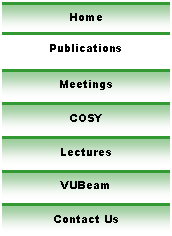
|
Reprint Server |



Taylor Models and Other Validated Functional Inclusion Methods
Abstract
A detailed comparison between Taylor model methods and other tools for
validated computations is provided. Basic elements of the Taylor model (TM)
methods are reviewed, beginning with the arithmetic for elementary
operations and intrinsic functions. We discuss some of the fundamental
properties, including high approximation order and the ability to control
the dependency problem, and pointers to many of the more advanced TM tools
are provided. Aspects of the current implementation, and in particular the
issue of floating point error control, are discussed.
For the purpose of providing range enclosures, we compare with modern
versions of centered forms and mean value forms, as well as the direct
computation of remainder bounds by high-order interval automatic
differentiation and show the advantages of the TM methods.
We also compare with the so-called boundary arithmetic (BA) of Lanford,
Eckmann, Wittwer, Koch et al., which was developed to prove existence of
fixed points in several comparatively small systems, and the
ultra-arithmetic (UA) developed by Kaucher, Miranker et al. which was
developed for the treatment of single variable ODEs and boundary value
problems as well as implicit equations. Both of these are not Taylor methods
and do not provide high-order enclosures, and they do not support intrinsics
and advanced tools for range bounding and ODE integration.
A summary of the comparison of the various methods including a table as well as an extensive list of references to relevant papers are given.
K. Makino, M. Berz, International Journal of Pure and Applied Mathematics 4(4) (2003) 379-456
Download
Click on the icon to download the corresponding file.
![]() Download Adobe PDF version (816231 Bytes).
Download Adobe PDF version (816231 Bytes).
Go Back to the reprint server.
Go Back to the home page.
This page is maintained by Kyoko Makino. Please contact her if there are any problems with it.